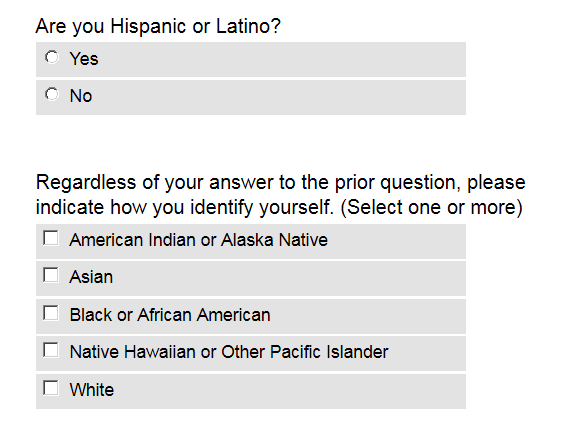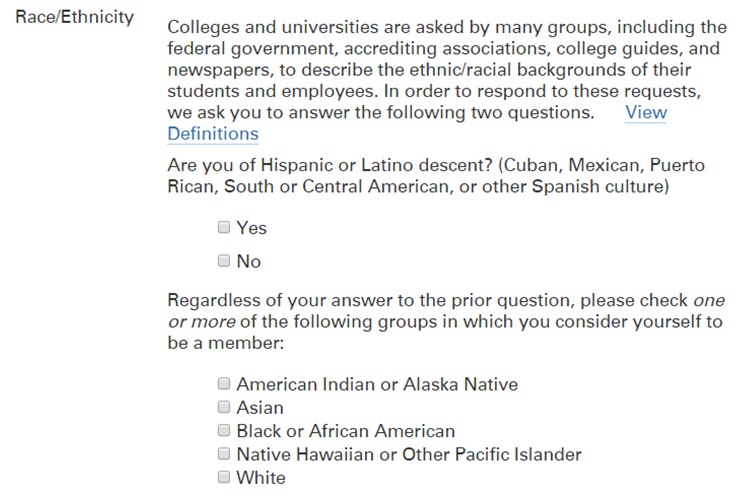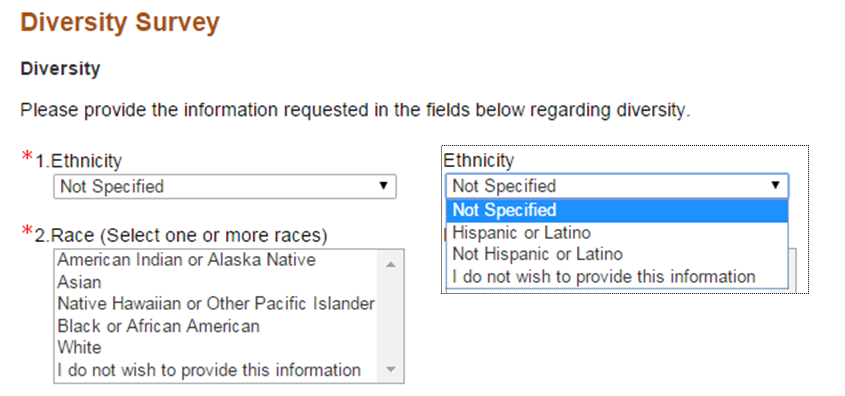Race/Ethnicity FAQs
- Why collect race/ethnicity data?
- Where does race/ethnicity data come from?
- Why is data collected in this two-part format?
- How do these data get reported externally (to the Federal government, on the Common Data Set, etc.)?
- How do these data get reported internally (to the Tufts community)?
1. Why collect race/ethnicity data?
Tufts, along with all other higher education institutions, is mandated to report to the federal government certain aggregate statistics about students, faculty and staff at Tufts. These statistics include breakdowns of each group by demographic categories, including race/ethnicity.
2. Where does race/ethnicity data come from?
For students, race/ethnicity data is stored in SIS; this is where it is pulled from for reporting purposes. The race/ethnicity data in SIS initially comes from the applications that students fill out for admission to Tufts. On the Common Application, the race/ethnicity question is asked as follows:

On the graduate applications, the question is similar:

For faculty and staff, initial race/ethnicity data comes from the job application:
After students enroll at Tufts, and after faculty and staff are hired, they are able to change their self-identified race/ethnicity at any time. For faculty and staff, this is done in eserve, and for students this is done in SIS.
3. Why is data collected in this two-part format?
On October 19, 2007, the U.S. Department of Education posted to the Federal Register the “Final Guidance on Maintaining, Collecting, and Reporting Racial and Ethnic Data to the U.S. Department of Education.” (See the Federal Register, Volume 72, Number 202, pp. 59266-59279). The proposed changes were necessary for the Department to implement the Office of Management and Budget’s (OMB) 1997 Standards for Maintaining, Collecting and Presenting Federal Data on Race and Ethnicity.
The Standards state:
This classification provides a minimum standard for maintaining, collecting, and presenting data on race and ethnicity for all Federal reporting purposes. The categories in this classification are social-political constructs and should not be interpreted as being scientific or anthropological in nature. They are not to be used as determinants of eligibility for participation in any Federal program. The standards have been developed to provide a common language for uniformity and comparability in the collection and use of data on race and ethnicity by Federal agencies.
The minimum categories for data on race and ethnicity for Federal statistics, program administrative reporting, and civil rights compliance reporting are defined by OMB as follows:
American Indian or Alaska Native. A person having origins in any of the original peoples of North and South America (including Central America), and who maintains tribal affiliation or community attachment
Asian. A person having origins in any of the original peoples of the Far East, Southeast Asia, or the Indian subcontinent including, for example, Cambodia, China, India, Japan, Korea, Malaysia, Pakistan, the Philippine Islands, Thailand, and Vietnam
Black or African American. A person having origins in any of the black racial groups of Africa.
Hispanic or Latino. A person of Cuban, Mexican, Puerto Rican, South or Central American, or other Spanish culture or origin, regardless of race.
Native Hawaiian or Other Pacific Islander. A person having origins in any of the original peoples of Hawaii, Guam, Samoa, or other Pacific Islands.
White. A person having origins in any of the original peoples of Europe, the Middle East, or North Africa.
OMB recommends that separate questions be used wherever feasible for collecting race and ethnicity data. Respondents are always offered the option of selecting one or more racial designations. When race and ethnicity are collected separately, OMB suggests that ethnicity shall be collected first, and the minimum designations are:
Ethnicity:
- Hispanic or Latino
- Not Hispanic or Latino
Race (select all that apply):
- American Indian or Alaska Native
- Asian
- Black or African American
- Native Hawaiian or Other Pacific Islander
- White
4. How do these data get reported externally (to the Federal government, on the Common Data Set, etc.)?
When race/ethnicity data are collected as described above, they are stored in six Yes/No fields: Hispanic/Latino, American Indian or Alaska Native, Black or African American, Native Hawaiian or other Pacific Islander, and White. For reporting purposes, a single racial/ethnicity designation for each individual is necessary to avoid counting individuals more than once. The Federal Registrar (Volume 72, Number 202, pp. 59266-59279) describes how race/ethnicity data should be condensed/categorized for reporting purposes:
The Department will require educational institutions and other recipients to report aggregated racial and ethnic data in the following seven categories: (1) Hispanic/Latino of any race; and, for individuals who are non-Hispanic/Latino only, (2) American Indian or Alaska Native, (3) Asian, (4) Black or African American, (5) Native Hawaiian or Other Pacific Islander, (6) White, and (7) Two or more races.
In addition, the Integrated Postsecondary Education Data System requires that individuals who are U.S. Nonresidents be reported as a separate category:
U.S. Nonresidents – A person who is not a citizen or national of the United States and who is in this country on a visa or temporary basis and does not have the right to remain indefinitely. NOTE – U.S. Nonresidents are to be reported separately, in the boxes provided, rather than included in any of the seven racial/ethnic categories.
Therefore, for external reporting purposes, data are combined into a single field according to the following rules:
- All individuals who are not US citizens or permanent residents are classified as “U.S. Nonresidents”
- All non-foreign individuals who indicate they are Hispanic or Latino are classified as Hispanic/Latino, regardless of race
- All remaining individuals who select only one of the five race options are categorized as that race
- All remaining individuals who select two or more of the five race options are categorized as “Multiracial”
- All those missing data on race/ethnicity are classified as “Unknown”
Note that this coding scheme necessarily undercounts the numbers of students identifying in any individual racial/ethnic group. For example:
- A student who identifies as Black and Hispanic is categorized as Hispanic, not Black;
- A student who is a U.S. Nonresident who identifies as Hispanic is categorized as U.S. Nonresident, not Hispanic;
- A non-Hispanic student who identifies as White and Asian is categorized as two or more races, not White or Asian.
5. How do these data get reported internally (to the Tufts community)?
Historically, Tufts has used only the Federal guidelines described above to report race/ethnicity data to both external and internal audiences. However, starting in the fall of 2015, Tufts began reporting race/ethnicity data to internal audiences using an additional methodology. The “new” methodology uses the same data as the federal, but allows individuals to fall into multiple categories—as many as were identified. U.S. Nonresident individuals who identified in one or more race/ethnicity categories are counted in those categories; those who have not are counted as unknown, along with the domestic students who did not identify a race/ethnicity. This methodology does not include a multiracial category.
Note that because individuals are counted more than once, this coding scheme gives complete counts of the number of students identifying in any individual racial/ethnic group. For example:
- A student who identifies as Black and Hispanic is categorized as Hispanic and Black;
- A student who is a U.S. Nonresident who identifies as Hispanic is categorized as Hispanic;
- A student who identifies as White and Asian is categorized as White and Asian;
- A student who is a U.S. Nonresident who did not identify a race/ethnicity is categorized as Race/Ethnicity Unknown;
- A student who is a US citizen or permanent resident who did not identify a race/ethnicity is categorized as Race/Ethnicity Unknown.